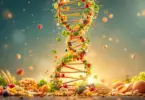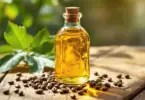By Sayer Ji
Contributing writer for Wake Up World
Given that cardiovascular disease is the #1 cause of death within industrialized societies, anything that can slow the underlying pathological process in its decades-long, mostly subclinical march towards heart attack, embolism or stroke, is worth considering as a prophylactic — especially if it is as safe, accessible and affordable drug alternative.
Indeed, a study published in the International Journal Cardiology indicates that aged garlic extract, in combination with vitamin B12, folic acid, vitamin B6 and arginine, is capable of favorably altering the ratio of brown to white adipose (fat) tissue surrounding the heart muscle, reducing homocysteine (a blood vessel damaging amino acid) and slowing the progression of coronary artery calcification in human subjects.[i]
[pro_ad_display_adzone id=”110028″]
The study involved sixty subjects, randomized to receive either a daily placebo capsule or a supplement containing 250 mg of aged garlic-extract, 100 µg vitamin-B12, 300 µg folic-acid, 12.5mg vitamin-B6 and 100 mg of l-arginine. From baseline to 12 months, the researchers found a strong correlation between the increase in the white fat tissue surrounding the heart muscle, also known as white epicardial adipose tissue (wEAT), and the level of coronary artery calcification. They found that at 1 year, the risks of coronary artery calcium progression and increased wEAT and homocysteine were significantly lower in the supplement group when compared to the placebo group. Researchers also found an increase in brown epicardial adipose tissue (wEAT) and improved vascular reactivity (an indication of lessened vascular dysfunction) in subjects who received the supplement.
There are two types of fat found in mammals, brown and white. Brown fat’s primary role is to generate heat in animals, which is why it is abundant in newborns and hibernating animals. White fat, on the other hand, is primarily a way of accumulating energy for storage, and does not have the high density of iron-containing mitochondria which enables it to generate heat and which makes it brown. The study found a higher ratio of brown to white fat around the heart muscle “correlated strongly with increases in vascular function measured by temperature-rebound and predicted a lack of CAC [coronary artery calcification] progression and plaque stabilization in response to AGE-S [supplement].”
Garlic is actually already well-established to have therapeutic properties in calcification disorders of the cardiovascular system.
Here is a review on the literature on this topic:
- Decalcification of hydroxylapatite calcium crystals: A 2003 study found that it was possible to dissolve the type of calcium hydroxypatite crystals found in cardiovascular pathologies with organic solutions of hawthorn, onion and garlic.[ii]
- Inhibits nanoplaque formation: A 2004 study found that garlic was able to inhibit lipoprotein associated arteriosclerotic nanoplaque formation.[iii]
- Retards progression of subclinical atherosclerosis: A 2004 study found found that aged garlic (in combination with B vitamins and arginine) inhibited the progression of subclinical plaque in human subjects.[iv]
- Inhibits coronary artery calcification in patients on statin therapy: A 2004 study found a 3-fold reduced progression in coronary calcification in those taking an aged garlic supplement versus a placebo.[v]
Other heart-friendly features of garlic include:
- Anti-platelet (blood thinning) properties.[vi] [vii]
- Anti-inflammatory.[viii]
- Improving endothelial function.[ix]
For additional Heart Disease research on the GreenMedInfo.com database, visit the links below:
- Aneurysm: Aortic : CK(10) : AC(1)
- Angina Pectoris : CK(93) : AC(11)
- Angina Pectoris with Normal Coronary Arteriogram : CK(20) : AC(1)
- Aortic Aneurysm : CK(52) : AC(6)
- Aortic Calcification : CK(180) : AC(7)
- Aortic Stenosis : CK(44) : AC(11)
- Apolipoprotein A/B ratio imbalances : CK(24) : AC(4)
- Arrhythmias: Cardiac : CK(451) : AC(63)
- Arterial Calcification : CK(154) : AC(25)
- Arterial Hardening: Elasticity : CK(128) : AC(17)
- Arterial Plaque : CK(439) : AC(20)
- Arteriosclerosis : CK(2154) : AC(123)
- Atheroembolism : CK(2) : AC(1)
- Atherosclerosis : CK(513) : AC(77)
- Atrial Fibrillation : CK(441) : AC(45)
- Atrial Fibrillation: Cardioconversion : CK(20) : AC(2)
- Atrial Flutter : CK(20) : AC(2)
- Bradycardia : CK(56) : AC(8)
- Cardiac Arrest : CK(40) : AC(2)
- Cardiac Arrhythmias : CK(485) : AC(68)
- Cardiac Hypertrophy : CK(54) : AC(22)
- Cardiac Mortality : CK(703) : AC(67)
- Cardiac noradrenergic hyperactivity : CK(2) : AC(1)
- Cardiac Surgery : CK(100) : AC(11)
- Cardiomegaly : CK(13) : AC(7)
- Cardiomyopathy : CK(77) : AC(15)
- Cardiomyopathy: Dilated : CK(2) : AC(1)
- Cardiomyopathy: Hypertrophic : CK(4) : AC(2)
- Cardiomyopathy: Peripartum : CK(1) : AC(1)
- Cardiovascular Disease: Infection : CK(2) : AC(1)
- Cardiovascular Disease: Prevention : CK(50) : AC(4)
- Cardiovascular Diseases : CK(5138) : AC(641)
- Carotid Artery Narrowing : CK(158) : AC(9)
- Carotid Stenosis : CK(209) : AC(14)
- Cerebral Stroke : CK(46) : AC(7)
- Cholesterol: LDL/HDL ratio : CK(432) : AC(58)
- Cholesterol: Oxidation : CK(457) : AC(98)
- Clogged Arteries : CK(2134) : AC(285)
- Clotting : CK(177) : AC(36)
- Coronary Artery Disease : CK(1253) : AC(136)
- Coronary Artery Ecstasia : CK(10) : AC(1)
- Coronary Artery Spasm : CK(2) : AC(1)
- Coronary Bypass Surgery : CK(100) : AC(10)
- Coronary Stenting : CK(33) : AC(5)
- Death: Statin-Induced : CK(14) : AC(3)
- Deep Vein Thrombosis : CK(511) : AC(10)
- Diabetes: Cardiovascular Illness : CK(666) : AC(104)
- Drug Induced Toxicity: Cardiovascular Disease : CK(1) : AC(1)
- Endothelial Damage : CK(31) : AC(10)
- Endothelial Dysfunction : CK(897) : AC(173)
- Fibrinogen: Elevated : CK(114) : AC(13)
- Gestational Hypertensive : CK(10) : AC(1)
- HDL: Low : CK(255) : AC(48)
- Heart Attack : CK(2598) : AC(117)
- Heart Attack: Recovery : CK(22) : AC(3)
- Heart Failure : CK(711) : AC(97)
- High Cholesterol : CK(1718) : AC(198)
- High Cholesterol: very low density lipoprotein (VLDL) : CK(24) : AC(9)
- Hyperlipidemia : CK(1211) : AC(109)
- Hypertension: Arterial : CK(1) : AC(1)
- Hypertrophy: Right Ventricular : CK(4) : AC(2)
- Hypotension : CK(3) : AC(1)
- Intima Media Thickening : CK(1878) : AC(41)
- Ischemia: Myocardial : CK(35) : AC(13)
- Lipid Peroxidation : CK(403) : AC(127)
- Myocardial Fibrosis : CK(2) : AC(1)
- Myocardial Infarction : CK(2632) : AC(117)
- Myocardial Infarction: Prevention : CK(54) : AC(3)
- Myocardial Ischemia : CK(87) : AC(37)
- Myocardial Necrosis : CK(2) : AC(1)
- Myocarditis : CK(54) : AC(8)
- Smoking: Cardiovascular Disease : CK(60) : AC(6)
- Statin-Induced Pathologies : CK(1570) : AC(315)
- Stroke : CK(540) : AC(47)
- Stroke: Hemorrhagic : CK(51) : AC(5)
- Stroke: Ischemic : CK(54) : AC(5)
- Tachycardia : CK(65) : AC(9)
- Thrombosis : CK(657) : AC(74)
- Triglycerides: Elevated : CK(340) : AC(65)
Resources:
- [i] Naser Ahmadi, Vahid Nabavi, Fereshteh Hajsadeghi, Irfan Zeb, Ferdinand Flores, Ramin Ebrahimi, Matthew Budoff. Aged garlic extract with supplement is associated with increase in brown adipose, decrease in white adipose tissue and predict lack of progression in coronary atherosclerosis. Int J Cardiol. 2013 Mar 1. Epub 2013 Mar 1. PMID: 23453866
- [ii] Patrycja Lipnicka, Maciej Pawlikowski, Roman Pfttzner. [The role of synthetic hydroxyapatite solution in the destructive process of arteriosclerosis]. Folia Med Cracov. 2003;44(1-2):187-99. PMID: 15232901
- [iii] Günter Siegel, Frank Michel, Michael Ploch, Miguel Rodríguez, Martin Malmsten. [Inhibition of arteriosclerotic plaque development by garlic]. Wien Med Wochenschr. 2004 Nov;154(21-22):515-22. PMID: 15638070
- [iv] Matthew J Budoff, Naser Ahmadi, Khawar M Gul, Sandy T Liu, Ferdinand R Flores, Jima Tiano, Junichiro Takasu, Elizabeth Miller, Sotirios Tsimikas. Aged garlic extract supplemented with B vitamins, folic acid and L-arginine retards the progression of subclinical atherosclerosis: a randomized clinical trial. Breast Cancer Res Treat. 2004 Feb;83(3):221-31. PMID: 19573556
- [v] Matthew J Budoff, Junichiro Takasu, Ferdinand R Flores, Yutaka Niihara, Bin Lu, Benjamin H Lau, Robert T Rosen, Harunobu Amagase. Inhibiting progression of coronary calcification using Aged Garlic Extract in patients receiving statin therapy: a preliminary study. Prev Med. 2004 Nov;39(5):985-91. PMID: 15475033
- [vi] H Kiesewetter, F Jung, G Pindur, E M Jung, C Mrowietz, E Wenzel. Effect of garlic on thrombocyte aggregation, microcirculation, and other risk factors. Inflammopharmacology. 2008 Apr;16(2):87-95. PMID: 2071264
- [vii] K C Srivastava. Aqueous extracts of onion, garlic and ginger inhibit platelet aggregation and alter arachidonic acid metabolism. Biomed Biochim Acta. 1984;43(8-9):S335-46. PMID: 6440548
- [viii] Marcela Alejandra Vazquez-Prieto, Cecilia Rodriguez Lanzi, Carina Lembo, Claudio Rómulo Galmarini, Roberto Miguel Miatello. Garlic and onion attenuates vascular inflammation and oxidative stress in fructose-fed rats. J Nutr Metab. 2011 ;2011:475216. Epub 2011 Aug 25. PMID: 21876795
- [ix] M Zahid Ashraf, M E Hussain, M Fahim. Antiatherosclerotic effects of dietary supplementations of garlic and turmeric: Restoration of endothelial function in rats. Life Sci. 2005 Jul 8;77(8):837-57. Epub 2005 Apr 14. PMID: 15964306
Recommended articles by Sayer Ji:
- The Powerful Aspirin Alternative Your Doctor Never Told You About
- 13 Evidence-Based Medicinal Properties of Coconut Oil
- Group Drumming Better Than Prozac, Study Suggests
- 25 Cancer Stem-Cell Killing Foods That Are Smarter Than Chemo and Radiation
- How Pomegranate Puts Chemo and Radiation to Shame
- How Turmeric Can Save the Aging Brain From Dementia and Premature Death
- Dramatic Recovery in Parkinson’s Patient with Gluten Free Diet
- 6 Bodily Tissues That Can Be Regenerated Through Nutrition
- Fluoride Literally Turns the Pineal Gland to Stone, Research Suggests
- Why All Diabetics Should Know About Turmeric
- Wheat Contains Not One But 23K Potentially Harmful Proteins
About the author:
Sayer Ji is the founder of Greenmedinfo.com, a reviewer at the International Journal of Human Nutrition and Functional Medicine, Co-founder and CEO of Systome Biomed, Vice Chairman of the Board of the National Health Federation, and Steering Committee Member of the Global Non-GMO Foundation.
For more, visit GreenMedInfo.com and Facebook.com/GreenMedInfo, or sign up for GreenMedInfo’s free e-Newsletter.
© March 30th, 2013 GreenMedInfo LLC. This work is reproduced and distributed with the permission of GreenMedInfo LLC. Want to learn more from GreenMedInfo? Sign up for their newsletter here.
[pro_ad_display_adzone id=”110027″]








